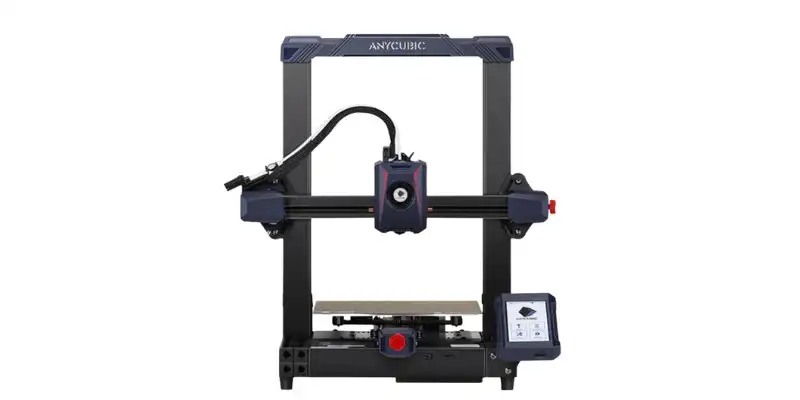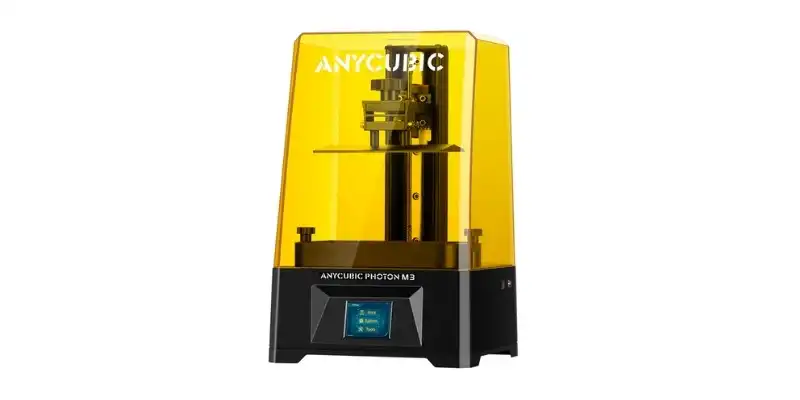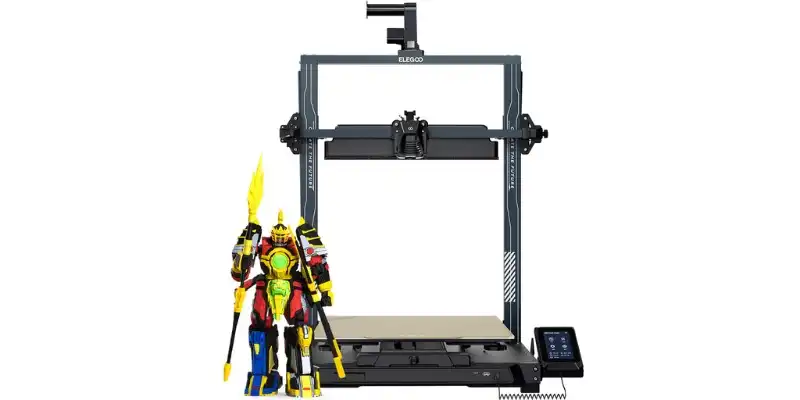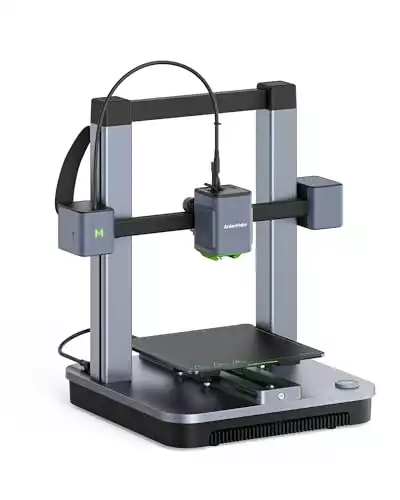Ten years ago, a 3D printer costing just a few hundred dollars would be considered impossible.
But now? We are spoiled with hundreds of great, low-cost printers from innovative companies across the globe.
|
4.6
|
4.8
|
4.7
|
|
$279
|
$209
|
$470
|
To help you pick, we’ve hands-on tested many of the most popular budget 3D printers and compared our results in this buying guide. We focused on reliability, speed, size, and ease of use – and we’ve attached images from our tests showing our findings.
Here’s our full picks:
| 3D printer name and brand | Type of Printer | Build Volume (mm) | Price | Lowest price at |
|---|---|---|---|---|
| Anycubic Kobra 2 | FDM | 220 x 220 x 250 | $279 | Anycubic here |
| Anycubic Photon M3 | Resin | 163 x 103 x 180 | $299 | Anycubic here |
| AnkerMake M5C | FFF | 220 x 220 x 250 | $399 | AnkerMake here |
| Elegoo Neptune 4 Max | FDM | 420 x 420 x 480 | $470 | Elegoo here |
| Toybox | FDM | 70 x 80 x 90 | $299 | Toybox Store here |
First… Remember The Pitfalls of Going TOO Cheap
There ARE some lower-priced 3D printers out there that do a fantastic job, reliably printing precise models at high speeds.
However, the lower the price you go, the fewer features, precision, and reliability you get. The cheapest 3D printers we recommend start at around $200-250, and though there are printers cheaper than this, we have not found any that reliably print to the level we would recommend.
At a certain level, it is worth paying an extra $50 for peace of mind and to avoid the headache of an inconsistent, often faulty printer.
We consider a “cheap” 3D printer to be under $500, and generally considered printers in the $200-400 range.
The Best Budget 3D Printers in 2024
1. Anycubic Kobra 2
- Price: Check price at Anycubic here / Check price at Amazon here
- Build volume: 220 x 220 x 250 mm
- Max speed: 300 mm/s
- Minimum layer height: 0.1 mm

The original Anycubic Kobra impressed when it launched in 2022. The Anycubic Kobra 2 takes those solid foundations and builds on them with 5x faster print speeds (up to 300 mm/s), a refreshed direct drive extruder, improved automatic bed leveling, dual z-axis threaded rods for better stability, and improved cooling system for rapid part cooling at higher speeds.
All these features for under $300 is a bargain for the print quality.
However, you’ll need to be comfortable with some hands-on tinkering, because the Kobra 2 isn’t as set-and-forget as higher priced 3D printers like the Ankermake M5C. The build quality, which is quite plastic heavy, reflects the low price too.
For around $80 less, you can also get the Ender 3 V3, the latest iteration of the famous Ender 3. It’s be redesigned with all the modern niceties, including direct drive, auto leveling, print speeds up to 250 mm/s, a sleek, futuristic design, and auto filament loading/unloading.
The decision here comes down to whether those extra 50 mm/s on the Kobra 2 will be put to good use. If the answer is no, the Ender 3 V3 is fairly similar but for less money – though most Ender 3s require a lot of tinkering over time.
Improved, upgraded version of the original Kobra, with much faster print speeds, good auto leveling, and a reliable direct drive extruder.
2. Anycubic Photon M3 – Best Budget Resin 3D Printer
- Price: Check latest price at Anycubic here
- Build Volume: 163 x 103 x 180 mm
- XY Resolution: 40 microns
- Minimum Layer Height: 10 microns

Pros
Large build volume.
Low cost, high quality.
Perfect for printing large minis faster, and several at once.
Cons
Slightly lower resolution than the Mono 4K – but this is because of the larger screen and build volume on the Photon M3.
For a very cheap pick, you can still pick up the standard Photon Mono, but for a bit more we recommend upgrading to the Anycubic Photon M3, with the larger build volume and 4K LCD screen.
Resin printers cure entire layers at once, unlike FDM, so the larger 163 x 103 x 180 mm build volume is a bigger advantage than ever: you can print a handful of tabletop minis at once, and at the same speed it would take to print just one. The extra height is also great for figures up to 180mm tall.
The Photon M3 is our pick for best cheap resin 3D printer, over the Photon Mono 4K, with the M3’s larger 7.6” screen for the larger build volume. You sacrifice 5 microns of XY resolution (40 microns vs 35), but this is barely noticeable even on the more intricate resin projects, and personally we prefer the larger size.
The 4K is a notable upgrade on the standard Photon Mono’s 2K LCD, which delivers good detail on even fairly complex D&D figures and other designs. The print speed is 50mm/h which is fairly fast, too, so you can print 28mm minis in just over half an hour.
This budget-friendly powerhouse delivers an extra-large 180 x 163 x 102mm build area perfect for printing batches of detailed miniatures.
Experience speedy 50mm/hr print speeds and crisp 40 micron resolution from the impressive 4K LCD screen.
Simple, reliable, and user-friendly, the Photon M3 makes resin printing more accessible than ever.
3. Ankermake M5C
- Price: Check price at AnkerMake here
- Build volume: 220 x 220 x 250 mm
- Max speed: 500 mm/s
- Minimum layer height: 0.1 mm

Having recently tested the Ankermake M5C, I can confidently report that it’s one of the most reliable, easy-to-use, and enjoyable 3D printers in the budget price range. It has incredibly fast print speeds up to 500mm/s, as well as automatic bed leveling, and a reasonably-sized 220 x 220 x 250 mm build volume.
One of the main reasons to buy the Ankermake M5C is how simple it is to get quality prints – even if you’ve never touched a 3D printer before. Excellent small touches like automatic nozzle purging, notches on the platform to slot in the build plate, and one of the simplest assembly processes we’ve come across.
With speeds up to 500 mm/s, it’s faster than the Anycubic Kobra 2 and its top 300 mm/s print speeds. To put that into perspective, a Kobra 2 would take around 22 minutes to 3D print a Benchy, whereas the Ankermake M5C cuts this down to around 17 minutes. The Ankermake also has generally better overall build quality, so if you have the extra budget then it’s the better pick overall.
Though, for only $70 than the Ankermake, you can get a much larger Elegoo Neptune 4 Max, offering 420 x 420 x 480 mm build volume. But the build quality, ease of use, and excellent software package of the Ankermake M5C packs in more value for the price in my opinion, unless you need the extra build space for larger projects and batch printing.
The Ankermake’s fans are loud – partly to compensate for the power needed to print reliably at such speeds. I was also let down by the flimsy quality of the spool holder arm that connects to the bowden tubing leading into the print head assembly. With not much force it’s likely to snap. The initially interesting one-click button is more of a gimmick than a practical add-on.
These are minor annoyances and overall the Ankermake M5C is one of the best cheap printers you can buy right now. You can also read my full review of the Ankermake M5C.
We also have an exclusive discount code: 3DSM5C.
Use this code and get $80 off!
- Dizzyingly fast print speeds – it printed a Benchy accurately at 500mm/s
- Superb print quality, especially on my articulated dragon print
- Impressive all-round build quality
- Sophisticated, responsive, and useful mobile app
- Tinker-free bed leveling and printing
- Direct drive extruder is always nice to have
- Missing SD Card slot
- Very loud operating noise levels. With noise-canceling headphones, I could still hear it from 20 feet away.
- No on-printer screen
- Strangely, it didn’t ship with any filament – not even a test sample
- Spool holder feels a bit flimsy to me
4. Elegoo Neptune 4 Max
- Price: Check price at Elegoo here / Amazon here
- Build volume: 420 x 420 x 480 mm
- Max speed: 500 mm/s
- Minimum layer height: 0.1 mm

The Elegoo Neptune 4 Max keeps costs relatively affordable with a large print volume, without sacrificing too much in parts and performance. It features a large 420 x 420 x 480 mm build volume, automatic bed leveling, Klipper-powered print speeds up to 500 mm/s, a direct drive extruder, Wi-Fi, and a nozzle that reaches up to 300°C.
For under $500, it’s a fine printer with plenty of print volume to play with for larger projects like vases, tabletop terrain, large figurines, and even cosplay props.
However, it’s very much a tinkerer’s printer and needs taming to shine, with quite a bit of time and energy needed for troubleshooting. But, if you’re up for the challenge, few printers combine a large print volume and impressive print quality.
One of the main alternatives to the Elegoo Neptune 4 Max is the Anycubic Kobra Max. It has a slightly larger 420 x 420 x 500 mm build volume, print speeds up to 500 mm/s, and a robust design. I still recommend the Elegoo overall though. You can also read my full review of the Elegoo Neptune 4 Max.
With a large 420x420x480mm build volume, integrated auto bed leveling, and fast print speeds enabled by Klipper, the Neptune 4 Max is an affordable option for hobbyists wanting to print big.
However, some tinkering is likely needed to get the best results.
- High potential print speeds (pre-installed Klipper + good processor)
- Huge 420 x 420 x 480 mm build volume
- 121-point mesh auto-leveling
- Direct drive print head
- Huge toggleable fan
- Likely to need tinkering to work properly
- Difficult to swap proprietary nozzle
- Few upgrades from the cheaper Neptune Max 3
5. Toybox 3D Printer – best for kids & absolute beginners
- Price: $300 — Available at Toybox store here
- Build Volume: 70 x 80 x 90 mm
- Minimum Layer Height: 200 microns
- Premium Features: Wi-Fi

Pros
One of the easiest 3D printers to use in the world.
Enclosure keeps the hot end away from kids for safety.
Comes with numerous toy files to print for free.
Cons
Small print area.
Only prints PLA and can only print at low temperatures.
The Toybox 3D Printer provides absolute beginners and young kids with a compact, easy-to-use machine to channel their creativity, completely free of the time-consuming and technical issues that most 3D printers have.
I tested the Toybox, and wanted to see if it really was as easy to use, and kid-friendly, as it was claimed to be. Overall I was hugely impressed – it takes less than a minute to change the different filaments, and I got it up and running in under 5 minutes from unpacking it.

The Toybox 3D Printer does, have some limitations that mean it’s not suitable for everyone. Mostly, the tiny 70 x 80 x 90 mm build volume is tiny, so you can’t print anything particularly wide, or tall.
It’s also only compatible with PLA, limiting your options for experimentation with other materials like ABS, Nylon or PETG.
But overall, it’s cheap, the most beginner-friendly 3D printer around, ideal for teaching your kids engineering, 3D design and math skills, and includes access to thousands of cool toys and other models you can print.

How To Pick a Budget 3D Printer
Buying a cheap 3D printer isn’t so much about what you get, but what you don’t get. We’re talking about the extra niceties that you sacrifice in paying less, which would make your printing experience that much more enjoyable and, to an extent, hassle-free.
Here’s a quick breakdown of where the cost-cutting generally takes place and the extras you might not get when choosing a lower-cost 3D printer.
Auto Bed Leveling
Auto bed leveling is very often the first feature to go when manufacturers look to keep costs down. It is by no means essential but makes calibrating a printer much more straightforward than manually turning a set of knobs under the bed to compensate for natural blemishes and inaccuracies on the surface.
However, some low-cost 3D printers do feature auto-leveling, such as the Anycubic Kobra and Prusa Mini.
Enclosure
Cheap 3D printers are few and far between because penning a printer into a more or less sealed chamber is expensive. The lack of an enclosure won’t be an issue for most only looking to dabble in PLA, PETG, and flexibles, but if you want to print ABS, you’re best opting for a 3D printer with an enclosure – or buying or building an enclosure for your printer.
| 3D Printer Model | Enclosure |
|---|---|
| Anycubic Kobra 2 | No |
| Anycubic Photon M3 | No |
| AnkerMake M5C | No |
| Elegoo Neptune 4 Max | No |
| Toybox 3D Printer | Partly Enclosed |
Assembly
Shipping a fully-assembled, ready-to-print machine costs time and money, so manufacturers often opt to ship their 3D printers semi-assembled or in kit form. The time and effort required to put them together varies, but expect to spend at least 30 minutes to an hour setting up before you can print.
| 3D Printer Model | Assembly Time |
|---|---|
| Anycubic Kobra 2 | 10-20 minutes |
| Anycubic Photon M3 | Comes fully assembled |
| AnkerMake M5C | 15 minutes |
| Elegoo Neptune 4 Max | 30-60 minutes |
| Toybox 3D Printer | Comes fully assembled |
Touchscreen
Though less of a luxury than they used to be, touchscreen interfaces on cheap 3D printers are another comfort that often goes out the window when it comes to cutting costs. They are generally replaced by rotary knob controls that while functional don’t have the intuitive appeal of a touchscreen.
Wi-Fi
SD card and often USB connectivity are relatively standard across most of the best cheap 3D printers. On the other hand, Wi-Fi isn’t and generally comes with a hefty premium. As a general rule, don’t expect Wi-Fi on 3D printers priced under $300, except in rare cases.
| 3D Printer Model | Wi-Fi Connectivity |
|---|---|
| Anycubic Kobra 2 | Yes |
| Anycubic Photon M3 | No |
| AnkerMake M5C | Yes |
| Elegoo Neptune 4 Max | Yes |
| Toybox 3D Printer | Yes |
Software
UltiMaker Cura is the easiest software to use for almost every budget FDM printer. Not only is it cheap, reliable, and intuitive, but comes with a range of optional settings, configurations, and add-ons to go as in-depth into the slicing process as you want.
Cura is frequently updated to factor in technological advancements, like the faster print speeds flooding the market recently, so you’re always making the most of your printers capabilities.
Build Volume
Build volume dictates the size of the models you’ll be able to print. The majority of cheap 3D printers have a build volume somewhere around 220 x 220 x 250 mm, this means the length, width, and height of prints you can fit in the printer.
But, should you want more space to work with, there are what are called large format printers with significantly larger build volumes. However, larger build volume usually means a higher price.
What’s Changed?
We wrote the first edition of this buying guide in 2018, and it has been updated dozens of times since then. Here are some of the most recent changes we’ve made.
Jan 2024 Changes:
- Removed the Prusa Mini and MK3S+. There are faster and better printers in these price ranges now, such as the Ankermake M5C.
If you enjoyed this article, you may also like:
- The Top 10 Large 3D Printers
- The 10 Best Cheap 3D Scanners








